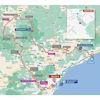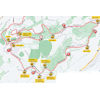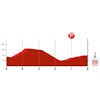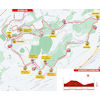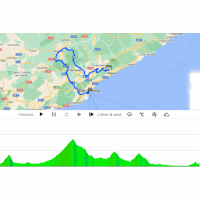Vuelta 2023 Route stage 2: Mataró - Barcelona
 Sunday 27 August - The 2nd stage of La Vuelta sets off from Mataró and takes in two climbs in the first half of the race. The finale on the iconic Montjuïc in Barcelona should favour punchers, while the race totals 181.8 kilometres.
Sunday 27 August - The 2nd stage of La Vuelta sets off from Mataró and takes in two climbs in the first half of the race. The finale on the iconic Montjuïc in Barcelona should favour punchers, while the race totals 181.8 kilometres.
The route climbs from the start on the Coll de Sant Bartomeu, an ascent of 6.6 kilometres with an average gradient of 4.5%. After a short downhill halfway the last 3 kilometres go up at almost 7%. The route then descends to continue on virtual flat terrain.
The Coll d’Estenalles appears after 53 kilometres. Again, not the hardest ascent of La Vuelta – on the contrary. With 12.1 kilometres at 3.9% the length is the most testing part of the climb.
The rest of the route is not flat either, but the main focus after the Coll d’Estenalles will be the finale in Barcelona, which is still more than 100 kilometres away.
The riders enter Barcelona from Molins de Rei in the Llobregat valley and continue to L’Hospitalet de Llobregat. The finale will be on fire where the TTT of day one finished, the Avenida de la Reina Maria Cristina. Shortly the riders tackle the climb to the Montjuïc castle. Ramping up to 19%, the 2.5 kilometres ascent averages 4.6%, while the last 900 metres rise at 9.4% to the intermediate sprint for time bonuses – 3, 2 and 1 seconds.
The riders then fly down a 2 kilometres descent to the flamme rouge before the last kilometre goes up at 4%.
The finale is a replica of 2012, when La Vuelta last visited Barcelona. Philippe Gilbert took the win in a two-up sprint with Joaquim Rodríguez. The rest of the field finished some 10 seconds later.
The first three riders on the line gain time bonuses of 10, 6 and 4 seconds, while the intermediate sprint comes with 6, 4 and 4 seconds.
Ride the route yourself? Download GPX 2nd stage 2023 Vuelta.
Another interesting read: results 2nd stage 2023 Vuelta.
Vuelta a España 2023 stage 2: routes, profiles, more
Click on the images to zoom
Watch the highlights of recent races here:
Related articles Favourites stage 2: Punchers on Montjuïc - Vuelta 2023 The Route - Vuelta 2023 Riders - Vuelta 2023 Withdrawals - Vuelta 2023 Route and stages - Vuelta 2023 Welcome to Cycling Paradise Andorra GC Favourites - Vuelta 2023 More articles Summer Olympics 2024 Paris: Route ITT (m/w)
Summer Olympics 2024 Paris: Start list + times ITT – men
Summer Olympics 2024 Paris: Start list + times ITT – women
Summer Olympics 2024 Paris: Route road race – men
Summer Olympics 2024 Paris: Riders road race – men
Summer Olympics 2024 Paris: Route road race – women
Summer Olympics 2024 Paris: Riders road race – women
Clásica de San Sebastián 2024: The Route
Tour de France Femmes 2024: The Route
Tour de France Femmes 2024 Route stage 1: Rotterdam - The Hague
Tour de France Femmes 2024 Route stage 2: Dordrecht - Rotterdam
Tour de France Femmes 2024 Route stage 3: Rotterdam ITT
Tour de France Femmes 2024 Route stage 4: Valkenburg - Liège
Tour de France Femmes 2024 Route stage 5: Bastogne - Amnéville
Tour de France Femmes 2024 Route stage 6: Remiremont - Morteau
Tour de France Femmes 2024 Route stage 7: Champagnole - Grand-Bornand
Tour de France Femmes 2024 Route stage 8: Grand-Bornand - Alpe d'Huez
Vuelta 2024: The Route
Vuelta 2024: Riders
Vuelta 2024 Route stage 1: Lisbon - Oeiras
Vuelta 2024 Route stage 2: Cascais - Ourém
Vuelta 2024 Route stage 3: Lousã - Castelo Branco
Vuelta 2024 Route stage 4: Plasencia - Pico Pitolero
Vuelta 2024 Route stage 5: Fuente del Maestre - Seville
Vuelta 2024 Route stage 6: Jerez de la Frontera - Yunquera
Vuelta 2024 Route stage 7: Archidona – Córdoba
Cycling Calendar 2024
Tour de France 2024: Withdrawals
Like our Facebook page and stay on top of all pro-race information!

